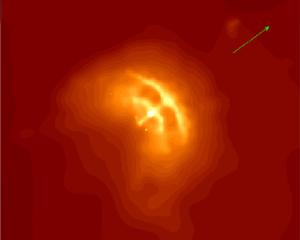Blog
Radio Glitch
13 August 2019
 NASA/CXC/PSU/G.Pavlov et al.
NASA/CXC/PSU/G.Pavlov et al.A thousand light years from Earth is an ancient remnant of a dead star. Known as the Velar pulsar, it’s outer layers were blown away long ago, leaving a core crushed by its intense gravity. It has 50% more mass than our Sun, yet has collapsed to a size smaller than many cities. It’s diameter is only 12 miles wide. All that mass in such a small volume means that it is not made of atoms or molecules, but rather dense nuclei, mostly neutrons.
As the star collapsed, its rotation increased significantly, like a figure skater pulling in her arms to make a spinning jump. It now spins so quickly that it makes more than 11 full rotations in a single second. The star also has intense magnetic fields, which accelerate charged particles to create intense beams of radio light. As the star rotates, these beams sweep across the sky like a lighthouse. One of those beams sweeps along Earth’s direction, and so with each rotation we see a bright pulse of radio light.
The Vela pulsar is the brightest radio pulsar in the night sky. Radio astronomers have long studied its pulses in an effort to understand the nature of neutron stars. It tells us about Vela’s rotation and mass, but sometimes it can reveal clues about the interior of a neutron star, which we don’t yet fully understand.
Radio pulsars typically flash at a very regular rate. Their pulses are so regular that we can use them as a kind of cosmic clock. But occasionally the radio pulses will glitch. The rate of the pulses suddenly increase for a bit, then return to their regular rate after a few weeks or months. Since the rate of pulses is due to the rotation of the pulsar, this means the pulsar must speed up suddenly before slowing down again.
We aren’t sure why it happens, but one idea is that stress builds up in the crust of the neutron star. When it reaches a breaking point, part of the crust would collapse and the pulsar would speed up slightly. Another idea is that the more liquid interior of the star can sometimes slosh into the crust, causing it to spin faster. We can’t study neutron matter on Earth, so it’s difficult to figure out how a star’s worth of neutron matter would behave.
Over the past several years a team of astronomers have studied the Vela pulsar very closely, making precise timings of its radio pulses. In 2016 they observed a glitch, but they noticed something a bit odd. Right before the glitch the pulses slowed down slightly. This means Vela’s rotation slowed a bit before suddenly increasing its rotation. Over the past few years the team compared their glitch with other observed glitches in 2000 and 2004. They saw the same slowdown a few seconds before those glitches as well. They recently published their results in Nature Astronomy.1
This slowdown would seem to agree with the liquid interior idea, but there isn’t enough data to be sure. So the team will keep watching Vela, eager to see when the next glitch will occur.
Gregory Ashton, et al. Rotational evolution of the Vela pulsar during the 2016 glitch Nature Astronomy (2019). ↩︎